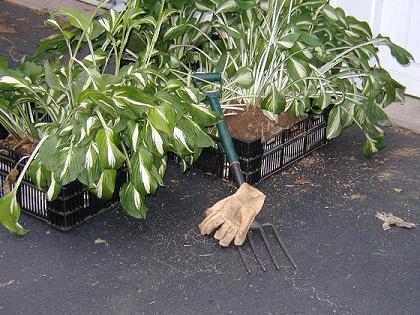
It rained yesterday. My goodness yes, it rained. Gray and some grumblings, a spit of raindrops on the windshield as I ran errands in the afternoon. With the price of fuel where it is (and creeping ever higher) I try to bunch up my running around. Yesterday included stops at the post office, the library, Wal-Mart and the supermarket. Skies ever darker, and more thunder. It was only as I turned into the road home that the skies opened up. With some stops and starts as the storm cells moved through we got 1.35 inches of rain in about 6 hours. Heavy curtains of rain, thunder just a few seconds after the lightning. Not, mind you, that things cooled off all that much. This is summertime in New Jersey, which means humid, hot weather. My weeds are loving it. As Marion Rombauer Becker notes in "Wild Wealth" (published by the Bobbs-Merrill Company, Inc. in 1971, long since out of print but occasional to be found in a second-hand book store) "Then, suddenly, one good rain plus a few hot days is enough to transform order into chaos."
But this morning, still overcast, was not as uncomfortable as it has been. I decided to go and evict some weeds. It's necessary. The entire garden could use some weeding. In some places not only have the plants disappeared, so have the paths. That's down along the drainage creek in more open, partially sunny areas where jewelweed, Impatiens capensis, is as tall as shrubs such as Pieris japonica 'Brower's Beauty'. In fact, some of the jewelweed is as tall as me. And there's another (fortunately infrequent) lettuce-type weed (by which I mean lobed leave on a stout hollow stalk with a somewhat milky sap) that grows 7 feet tall. Luckily it has shallow roots and is easily yanked loose. But at this time of year it is mostly jewelweed that forms dense stands. My earlier efforts against the rampageous garlic mustard, Alliaria petiolata, have paid off. There are few, if any, seed-bearing plants in the gardens, and not too many seedlings. And I've been going after bedstraw, Galium aparine. Becker writes of it: "Agile bedstraw climbs weightily over low groundcovers like a pale crocheted afghan." I find that it likes to clamber too, ascending or creeping or scrambling into perennials and shrubs as a means of support. As much as 4 feet long and looking like a straggly woodruff, to which it is related, bedstraw produces trios of small sticky green spheres for seed, that attach to my socks and my blue jeans, and at the right time of year the cats come in festooned with them. Clever plants, to use us as their dispersal mechanism. Becker mentions that you can "flail your arms in wide arcs and the sticky stems of bedstraw adhere, pulling more bedstraw with them, and in no time you can rid yourself of great muffs of it." Timing is important, because over-ripe bedstraw seeds, abandoning hope of catching a ride, simply drop where the original plant was growing. Disturb it then, and any seeds left on the dying annual fall far and wide as you wad them up to discard in the weeding bucket.
Into the woods I go, tool belt cinched around my waist with scissors, clippers, folding saw, hori-hori Japanese farmer's weeding knife, and three-clawed scratcher-puller dingus in their various holsters. Since I'll be pulling and dumping, one bucket will suffice. Focus, I've decided, shall be my mantra. Also "Once begun is half done." I can spend more time, way more time, thinking about doing something than the actual time spent accomplishing it. I believe that's called procrastination.
For better than three hours I weed. When the soil is this wet the roots don't hold as firmly. Even seedling maples, spice bush, and other woody invaders can be hand-pulled, along with all the herbaceous perennial and annual weeds. I expose ferns and hostas, pulmonaria and Siberian bugloss, Brunnera macrophylla. I clear beneath the branches of several star magnolias, Magnolia stellata, around the base of four Fothergilla gardenii, and provided breathing room to three seedling Cercis chinensis - but since they're more than 3 feet tall I should now be calling them saplings. Bucket after bucket packed with weeds are carried into the woods and dumped near the property line behind a sparse but thickety tangle of spicebush, some viburnums, and multiflora roses that I periodically whack back. I'm really on a roll now, uprooting a spreading colony of goldenrod. There's a powdering of dirt from fingertips to elbows. My jeans are soaked to mid-thigh with dampness transferred from the weeds I've been plowing through, with a nice, clinging film of dirt adhering to the fabric. I'm really glad I had my hair cut short a couple of months ago. Earlobe length is more practical in this weather, for these chores, than braided and still long enough to reach below my shoulder blades.
I call it quits about noon. Pull just a few more weeds. Empty the bucket one last time. Strip off in the laundry room and head upstairs for a shower. Tomorrow . . . tomorrow I'll mulch where I weeded today.
Construction is disruptive. Friends of mine have to have their in-ground oil tank removed. I don't think it is leaking. Rather, the company that provides their homeowners insurance wants it out. So the sunroom cum greenhouse that's over the oil tank has to be completely removed. The fence around the little garden outside the sunroom has to be removed. Several well-established shrubs have to be transplanted. At this point Judi felt enough was more than enough to be dealt with, and the hosta that also had to move could go elsewhere. Lucky me was recipient of three crates of hosta. And that was not all of them, there were more hosta, going to other gardens.
Understand that we're back into hazy, hot, and quite humid weather. In other words, summer in New Jersey. Given her druthers, Judi would have been peacefully watching the goldfish in her pond, and the hosta would still be in her garden. The tail end of June is not the time to transplant any perennial except bearded iris. Judi didn't have a choice. The hosta had to go. These are not cutting edge cultivars with fancy names that are priced by the leaf. When I was a child growing up in Brooklyn these were called funkia, or maybe plantain lily. They're good, sturdy, care-free reliable plants. One of Judi's pass-along hosta is the all green leav Hosta ventricosa, which has spikes of lavender to purple flowers in early July. The other, with a white center to its green leaves, is a form of Hosta 'Undulata'. The specific epithet, undulatus, means wavy, and different clones are variable in the degree of waviness from subtle undulation to quite twisted. To quote W. George Schmid in his excellent book "The Genus Hosta" (published by Timber Press in 1991) "This taxon is one of the best-known classic, cultivated hosta . . . " He points out that this is a variable, mediovariegated hosta with a number of different clones. In its best form the leaves are splendidly marked with light and dark green, chartreuse, and white. Since the plants that Judi gave me have a white central stripe on a green leaf it is probably Hosta 'Undulata Univittata'.

I got home around 4:30 p.m. and, having decided to deal with the hosta after dinner, set the three crates in the shade to wait for the temperature to abate, even if only a little. At 8:00 p.m. it was 76.8° Fahrenheit. Still humid. No way was I going to plant. I decided to divide the hosta, trim back some of the foliage from the leafiest divisions, and flat them up in the crates to adjust to their abrupt disruption. If they stayed in the crates until September, that would be fine too. (Unless I need the crates for something else.) The larger clump of 'Undulata Univittata' provided me with 14 divisions. The smaller one, half that many. The two clumps of Hosta ventricosa broke down into 7 or 8 pieces. I shook as much soil off the roots as possible, then mixed it with my usual potting compost to give the roots something lighter to readjust to than the New Jersey clay loam that had been their home. I watered the crates and then sprinkled Milorganite as a deer deterent. After tidying up I went back to the house, and dusk was far enough along that the automatic lights came on as I approached.
I've been thinking of where to plant the hosta, when they do get to settle into the garden. Hosta ventricosa will go on the far side of the drainage creek with some evergreen Christmas fern, Polystichum achrostichoides, for textural contrast. Schmid mentions the variegated hosta as often being used as an edging plant. Perhaps I'll make a sweeping line of it, bordering a path on the near side of the drainage creek. There's a place where bear's foot hellebore, Helleborus foetidus is making a fine colony. This hosta would make a nice foreground planting for the hellebores' dark green, fine textured leaves.
And if I'm lucky it will rain some more tonight. That would be good for the hosta. And also for the rest of the garden.
My Arisaema candidissimum are in flower. This exquisite relative of our North American jack-in-the-pulpit, A. triphyllum, does not make an appearance until very late, in mid-June. The spathe is very beautiful, striped in pale pink and white, looking like the finest porcelain. I like arisaema - they're wonderful plants for the woodland, with (take your pick) intreguing, unusual, bizarre flowers. And, important in my rural / suburban woodland, neither voles nor deer will eat them. I've added several other Asiatic species in addition to A. candidissimum, and would like to add more. The following are two favorites of mine. A. thunbergii var. urashima has pedatisect, dark green leaflets splayed out like fingers and a dark chocolate brown spathe arching over a whip-like extension on the spadix, long enough to trail on the ground. The other is the cobra lily, A. ringens, with a pair of large, glossy, tripartite, apple green leaves and a curled over spathe resembling a cobra's hood to some, or a hopalite's helmet to others. The plants grow from seed fairly easily. The difficulty is getting seed. Membership in the North American Rock Garden Society, whch as a members' benefit has an extensive seed list, is the best option. If you are into instant gratification, and do not want to wait three years or so until the seedlings reach blooming size, be warned that tubers, especially flowering size ones, are expensive, often $30 each, or more for the rarer species. Ellen Hornig of Seneca Hill Perennials in Oswego, New York has a tempting assortment of arisaema species and some Seneca Hill selections listed in her catalog.
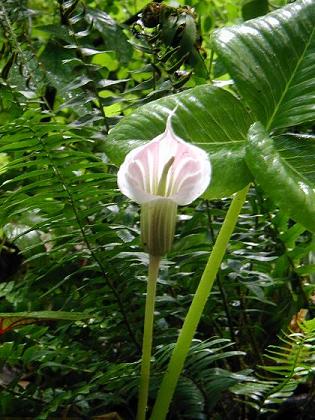
I have a couple of arisaema relatives growing in my gardens too. Most pinellia are invasive thugs, spreading far and wide, and difficult to evict once they are established in a garden. Fortunately, there's one with better manners. Pinellia cordata is dainty enough for a flower pot, with silver flushed green leaves that are red beneath, like some begonias. The little "flowers" have a sweet scent, another good reason to grow them in a pot. Then it is simple to lift them up to my nose for a sniff. Another darling is the mouse-tail arum, Arisarum proboscideum, which hides its spathe under the low-growing foliage. All, that is, except for the tip, which protrudes straight up like the tail of a wee dark brown mousie hiding under the leaves. It goes dormant in summer, so I have to be careful not to dig where I'd disturb the small lumpy tubers. Diana Chapman of Telos Rare Bulbs is offering mouse-tail arum for sale in her 2005 catalog, along with other species of arisarum, a few biarum, and some nice arums. She specializes in bulbs of the western United States, Central and South America, southern Africa, and oddments from other parts of the world.
Inspired by yesterday's Cutting Edge Combo lecture focusing on tropical plants, I potted up caladiums that had been started in my greenhouse back in March. Since they were going into the woods, these would be simple, two or three plant combinations, the containers set at the edge of the steps or adjacent to a path. First up was a wide, rather shallow fiberglass bowl purchased just this morning at a big box store, along with wire shelving for a closet upgrade, five 50-gallon storage containers for same, and four 8-foot long 1 by 4 boards, ditto. Well, I might as well get something out of the trip too. The bowl, its knock-out plug removed so water can drain, was set on a tree stump near the steps. I used my standard mix of purchased soil combined with Pro-mix at approximately 50:50 ratio. A scoop of expanded polyacrylamide water-holding crystals, previously hydrated, and a handful of slow release fertilizer, thoroughly stirred into the potting mix. The first caladium is a real sweety. Diminutive, Caladium humboldtii has dainty little white splashed green leaves only 2 or 3 inches long and an inch or two wide. I had started the lumpy tubers in a 6-cell pack with huge compartments, setting it on a heating mat for bottom warmth. The 5 tubers had by now sent up so many leaves that the cell pack was a solid mass of foliage. Interestingly, when I tipped each tuber out of its cell, it fragmented in three, or even more pieces, each with ample leaves and roots. No idea if this is typical of the species, but it certainly made it easy to spread the little caladium around in the container. In fact, three were sufficient. Next was a trailing silver-leafed lamium of some sort or another. Sold as a summer bedding plant, I rather suspect that if I plant it out at summer's end it will do just fine as a perennial in the garden. A few white flowered, green leaved fibrous-rooted begonias, and I considered it done. This container, with its whites and silver, will guide me as I stumble out of the woodland garden at dusk.
Next was a wooden, window box-y looking container. Paul had drilled three drainage holes in the bottom, and I painted the inside with that black gunky tree wound paint that's no longer used on trees but is great for something like this, protecting the wood from decay. The exterior received two coats of deck sealer. The container then sat for a couple of months so I'm sure that any noxious fumes have evaporated. Set off the edge of the path deeper in the woods, this container received 5 Caladium 'Pink Gem' and some pink flowered, copper leaved fibrous rooted begonias.
Now I'm on a roll. On to the largest pot, a attractive, round, soft clay Malaysian one, in earth tone brown with grooves in the sides. In fact, this is the one that the 9-foot tall banana spent the winter in, in my bedroom. Now the pot is perched on a stump near the drainage creek, planted with Canna 'Stuttgart'. I'm hoping that there's sufficient light for this temperamental beauty to thrive. Its narrow pale green leaves splotched with gray-green and white, it has a dreadful tendency to burn if given direct sunlight. Really, what it prefers is a site open to the sky with bright light. We'll see. In addition I planted five Caladium 'Aaron', with a large white central blotch blurring into moderately wide dark green edge. And finished things off with some more of the white flowered begonias.
Last was a smaller pot with just one caladium. I purchased 'Thai Beauty' at Atlock Farm last Sunday. It has medium green leaves with rose-pink "bubbles" of color near the center. Pictures I've seen suggest that at maturity the leaves will be entirely pink, with a roadmap of green veins threading through. A few pink flowered begonias, set the pot at the edge of the middle step, and I was done for the day. Done, that is, other than pushing the cart with buckets, watering can, empty plastic pots, fertilizer container, etc. up the driveway and putting things away. While this may not sound like much, between preparing potting mix, moving stuff down to the woods, and finally planting containers, we're talking better than two hours of sweaty work. Sure hope it doesn't take the full month John Beirne suggested last night before they look good!
Demonstrations and explanations of container gardening are a feature of Wednesday evenings in June at Wave Hill in Riverdale, New York. The first, on June 8th, featured herbs. Next, on June 15th, focused on alpine troughs. And June 22nd heralded the tropical look. (The final presentation, on June 29th, will demonstrate the planting and maintainence of ornamental and edible vegetables in containers.) This year I just happen to have an assortment of gingers, elephant ears, a couple of small bananas, some caladiums . . . and this year being what it has been, many are still in their by now rather small containers, practically begging for room to grow. Options, possibilities, someone else's take on how-to and what-to-do might spark my imagination.
Lillie had something else planned, so I coaxed my friend Ellen into joining me. "We'll leave earlier," I said, "and miss the rush hour traffic. That also gives us time to walk through the gardens, visit the art exhibits in the galleries, and then listen to the lecture before heading home." It didn't take much convincing. Ellen had never been to Wave Hill, and readily agreed to join me.
First the weather report said rain in the morning. That would be fine. However it was the morning that was fine. By noon there were puffy white clouds ponderously moving across the sky. It was somewhat grayer by the time we left. And somewhere on Route 287 it began to rain. But not as heavily as last Thursday, and ending before we reached Wave Hill.
We arrived shortly after 4:00 p.m. and had just over two hours before the demonstration. Ellen was especially pleased to see plants she'd read about but never seen growing, such as a sea holly, Eryngium species, in bloom just outside the front garden's rustic fence. We went through the Herb Garden, paused to admire the bonsai in the Alpine House, then into the Wild Garden, where spires of verbascum made stately yellow exclamation marks, hollyhocks with deep garnet flowers, and a vivid combination of orange butterflyweed, Asclepias tuberosa mingled with Salvia superba and its wands of indigo blue flowers suggested a planted by nature effect as all the plants are selected for their wildflower-like appearance: single hollyhocks, for example, rather than powderpuff double one..
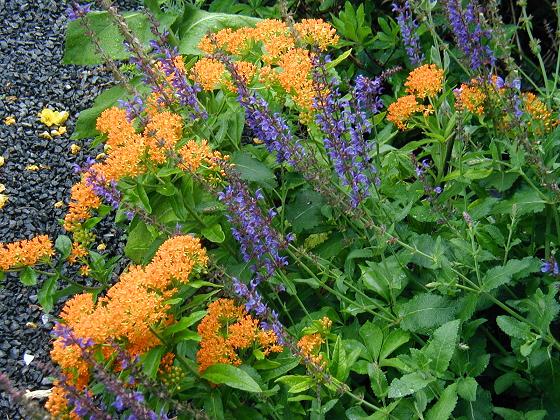
From the lower path we strolled passed the upper pergola to the Monocot Garden, filled with bananas and grasses and all sorts of plants that germinate with but a single leaf (rather than a pair of leaves, as dicots do). The real spendor of this garden space, bounded by the two pergolas, is the Aquatic Garden, just coming into verdant growth that will swell until it peaks in late summer and early autumn.
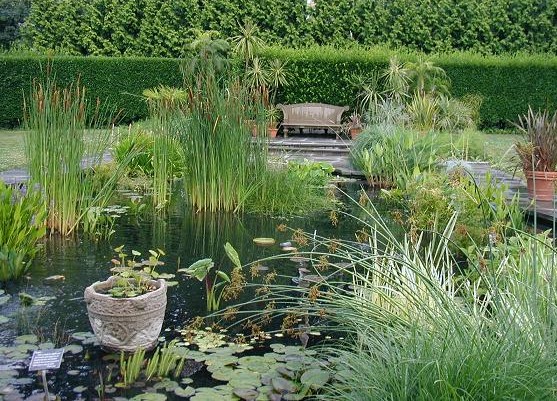
From here we walked along the upper path of the Wild Garden, down to and across the Great Lawn, and into Glyndor House, as I especially wanted to see the Bronx Lot Florilegium display, with drawings of the plants found growing in a small portion of a South Bronx empty lot. Empty of buildings perhaps, but filled with plants and detritus. The plants are completely, exquisitely drawn, down to their very roots. Some drawings include nearby artifacts, such as a flattened plastic bottle. Pristine plaster casts transmogrify broken glass, a baseball, and other such abandoned debris into art. The florilegium itself is on exhibit in a glass case, as wonderful a record, as beautiful a display as any of its 17th and 18th century counterparts. The exhibit is on display at Glyndor House through August 28th.
We retraced our steps beyond the gardens and the visitors center to Wave Hill House, where the café is located and another art exhibit is on display. "All Things Being Equal" has an enchanting, shall I call it trompe l'oeil premise. Bryony Ann Romer took a scaled model of Wave Hill House, and set it in various well-known and overlooked landscapes and natural spaces throughout the city, in various seasons. She then photographed it, with the resulting images giving the model the appearance of being a full size building. A tussock of moss in the foreground becomes a grassy knoll, and so on. Fanciful, fairy-tale imagination, offering a fresh perspective on size, scale, and our place in the landscape. This exhibit is also on display through August 28th.
Now ravenous from our intense looking and talking, walking and viewing, Ellen and I each had a cup of well flavored cold gazpacho, and a sandwich. Mine was roasted pieces of thin sliced carrot with goat cheese and some greens on dark bread. After wiping the chairs with a couple of paper napkins we were able to enjoy our repast while sitting outdoors (aided by fact that we were both wearing blue jeans, practical clothing for gardeners, and for garden viewing where one often bends or kneels to admire some small treasure of a plant.) After being besieged by English sparrows (my fault, I threw a crumb of bread to one, next minute there were two, then four) I finished the remainder of my sandwich. Time was moving on, the demonstration was surely being set up, and Ellen and I want a seat right up front, close to the action.
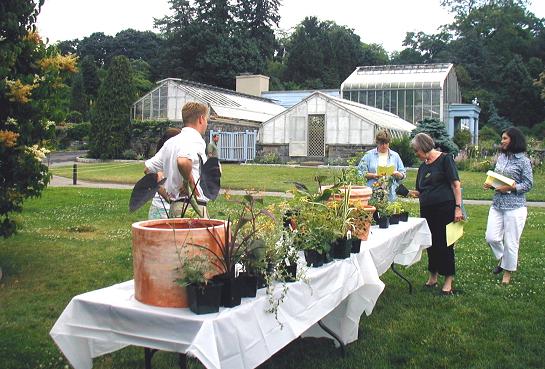
Two large tables were set up on the lawn, in front of a number of folding chairs. There were a goodly number of interesting plants: a banana, a black-leafed elephant ear, a copper-bronze cordyline, a small leafed silvery helichrysum, a diversity of coleus, and more. Perhaps the most unusual was flax lily, Dianella tasmanica 'Variegata', resembling a small phormium with crisply white edged, arching, sword-like leaves. There were some very handsome terra cotta pots. Except they were not, they were faux terra cotta, made from fiberglass or some other such substance. Light weight, easy to haul around, and even with that empty clay pot "clunk" when set down a little too forcefully on the table. It is difficult to pry gardeners away from plants and into their seats. But without too much ado we were ready to begin.
Each of the Cutting Edge Combo lectures had a different presenter. This evening it was John Beirne, who manages the horticulture therapy program at Newbridge Services in Pompton Plains, New Jersey. Apparently every summer they have a huge tropical plant garden. What's huge? Well, John told me he has 200 bananas in the garden. The Cutting Edge Combo program was barely an hour, and packed with information, presented in a casual, relaxed, friendly yet authorative manner, as all the while John is demonstrating: scooping up Metro-Mix, assembling plants, holding one up for our admiration as he relates useful details, then deftly setting them into the container.
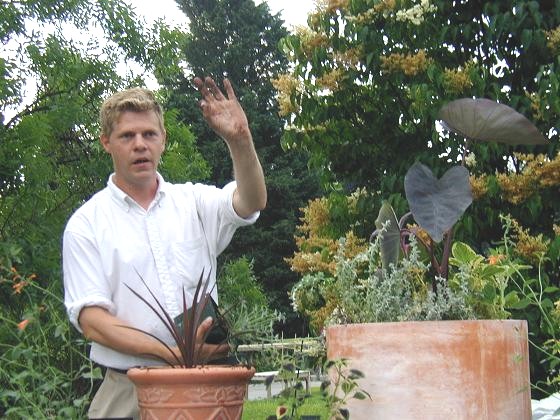
Some points to remember: use large containers. The matted roots from the community of plants need room to grow, and ample water. Small pots mean little soil, the nutrients will quickly be depleted, and the plants will grow poorly. Start the plants off right by adding a slow-release fertilizer to your potting mix at the time you're planting up the container. Additionally, use a liquid fertilizer every 2 to 3 weeks. The soil mix should be light and fluffy, and drain well. Remember to leave room at the top - empty air, an inch to an inch and a half down from the rim of the container. That provides room to water without splashing mud all over your deck or terrace. Keep in mind that containers look a little disappointing immediately after they're planted. The plants look lower / smaller than they did when in their indvidual pots. Within a month the plants will come together. Only buy plants with labels. Labels should have the Latin name as well as the common name, suggestions on how big the plant will get, does it prefer sun or shade, etc. "But remember," John told us "everyone is their own best judge. Have fun!"
Layer plants, John reminded us, so that you're combining upright plants with bushy and trailing plants. Select plants with a variety of foliage textures and other-than-green leaf colors. Foliage provides more staying power, has a more extended period of beauty and interest than do many flowering plants. His recommendations include flowering maple, Abutilon cultivars, with various options for foliage color on their maple-like leaves, and attractive flowers too; parrot leaf, Alternathera ficoidea cultivars, small mounding plants with a diversity of foliage color options; snow bush, Breynia disticha, with white, pink and green leaves - but look for the dwarf cultivar, called snowball; purple velvet plant, Gynura bicolor, with plush purple leaves, like stroking a piece of velvet, and more. Coleus, with the plethora of options available today are another favorite, as are the so-called Spanish thyme, Mexican mint, Cuban oregano, common names assigned to the various cultivars of Plectranthus.
John's first container used a black elephant ear as its focal point plant. Just because it is the focal point plant does not mean it be plunked right in the middle of the container. Off-center works very nicely. The cordyline was considered, but John then decided it would be a "solo act," potted up individually, on its own. The elephant ear was brightened, lightened in its ponderous darkness, with a small, silver-leafed helichrysum, set towards the rim to allow it to spill over the edge and somewhat soften the look of things. The upright purple passion plant, Gynura bicolor, was next, then a coleus with small, orange-ish leaves accented with a red central blotch. SInce the texture of coleus and helichrysum were rather similar, a large-leaved plecranthus with large, fuzzy, yellow-edged leaves was planted between the two. An agastche with range flowers, and a small grayish leaved geranium with a few narrow-petalled, deep burguny flowers on wiry stems completed the ensemble. The second act began with a banana, again purple passion plant, Gynura bicolor, a different coleus, a verbena with finely dissected, thread-fine leaves and mauvish purple flowers, then flax lily, Dianella tasmanica 'Variegata', its white-edged linear leaves shoting up through the banana's bolder foliage, and a different plectranthus to finish the composition.
Unfortunately, neither container was raffled off as a door prize.
Ellen and I went to the shop in the visitors center. We both bough a flax lily, Dianella tasmanica 'Variegata'. She bought a banana, I got a chartruese-leaved oxalis. And we each bough a snowball, Breynia disticha.
One last stroll through the front garden, where the last of the day's light made luminous the blue flowers of branching larkspur, Consolida species, with the trumpet flowers of Lilium regale tangled in their stems.

A glimpse of our destination, the George Washington Bridge, to carry us west across the Hudson River, homeward bound to New Jersey. Satisfied, satiated (for now, for the moment) with the beautiful plants, splendid gardens, and horticultural lore that were all a part of our visit to Wave Hill.
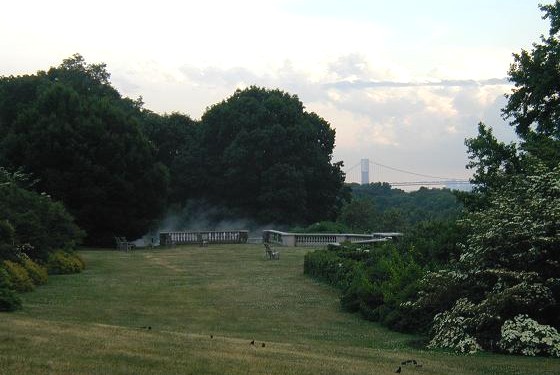
There is a veritable mountain of mulch at the bottom of our driveway. Last year I told the crews trimming the power line right-of-way along my road that they were welcome to dump the branches that had been run through a chipper off to the side at the bottom of my driveway. I even made a nice little "chips here" sign, and put it where I wanted them to drop a truck load. Dump truck load that is. They dropped off three truck loads and would have brought a fourth had I not said "Stop!" The chips and leaves have been aging nicely since last summer, and there is ample mulch for the foreseeable future. Of course it is all at the bottom of the driveway and there are places up top that could benefit from mulching. When asked, Paul obliges by hitching the small red cart to the quad and running a shuttle service. I was shoveling mulch into buckets for a powered assist uphill when what did I find but
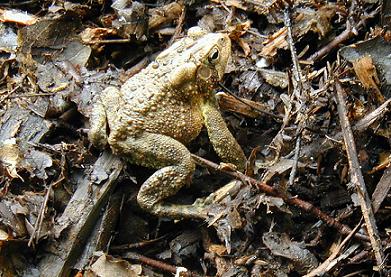
a small toad. No doubt he was equally astonished to be so abruptly exposed. I gently shooed him back into a nice, damp little cavity in the mulch pile and told him to have a good time eating bugs. Then shifted a few feet over before filling more buckets with mulch.
There's this wonderful native vine. It will grow in full sun to fairly heavy shade, has attractive glossy foliage that turns a wonderful rich burgundy red in autumn, and birds love to eat the berries. I saw it being cultivated in the Chelsea Physic garden in London, but not here. Why? Because Toxicodendron radicans, poison ivy, is just not the kind of native plant that most gardeners want to encourage. Earlier this spring I found a large vine of the itchy stuff heading 20 feet up one of the sycamores along Magnolia Way. It had been overlooked long enough that it had that hairy look, from all the hold-fasts it developed to help it cling to the tree trunk. Boldly I went after it with a pair of loppers, removing a 6 inch chunk near the base. Then painted the bottom portion with brush killer, cursed it roundly and told it to die. I let the cutting portion of the loppers soak in mineral spirits for 20 or 30 minutes, to remove any urushiol, the stuff that causes the itchy rash, from the blades. While they were soaking I washed my hands and arms with Fels Naptha laundry soap, lathering it up, allowing it to dry, then rinsing off. I remember my mother using it for the very same purpose when I was a child. Yellowish brown in color, generally found in the supermarket's laundry aisle, the soap works really well if applied within about 20 minutes of contact.
My friend Carol's husband John is a chemist. He told her to apply cooking oil all over the exposed skin area, then wash with dish detergent. The oil first goes slimy, then finally rinses away. Again, apply within 20 minutes. And, Carol says, since she's followed John's advice she hasn't even had any itching or redness, let alone blisters.
A folk remedy to relieve itching from the rash, which also works as a preventative if applied promptly after exposure makes use of the juice from touch-me-not, Impatiens capensis. Just grab a bunch of the tall juicy stalks, crush and rub over the skin. I know at least one person who gathers lots of touch-me-not (also known as jewelweed), stuffs it into a large plastic bag, and crushes the stems. Then he hangs the bag up so juice can collect in the lowest corner. The collected juice is frozen in an ice cube tray dedicated to that purpose, and saved in the freezer against possible need for it in the future.
I was making tomato cages today, for the heirloom tomatoes that you can read about in the June 6th diary entry. Here it is just two weeks later and they've gotten large enough that some have a few flowers and Marmande even has a small green tomato. Clearly time for some support. I wanted concrete reinforcing wire, but could only find 100-foot rolls. John gave me a 50-foot roll of wire fencing, 4-feet wide with 2-inch by 4-inch openings. Cannot really fit my hand through, let alone bring it out while clutching the large, juicy tomatoes I am hoping for. So this morning I was manufacturing tomato cages.
Cut a 5 foot plus one opening length of wire. (This gets more complicated the closer you get to the core of the roll of fencing, where it is very tightly curled around itself.) This is the length needed to fit the inside circumference of my large pots. Kink the horizontal wires of the outside vertical file row, alternating in / out / in / out. Then slide a 6 foot bamboo pole into the file row. This will provide something to jam into the soil into the pot to stabilize the cage and stiffen it. Next I needed to snip out alternate wires to make bigger, 4 inch by 4 inch openings. I left the top two horizontal rows uncut, as well as the two vertical files at either end. Wires were only cut from every third vertical/ third horizontal opening. This means I didn't need to cut a whole lot of wire (tiring work after a while), the cages will remain reasonable sturdy and stable, and I'll still be able to reach in to harvest tomatoes. The result is one 4 inch by 4 inch opening, then an 8 inch by 4 inch uncut area before the next 4 inch by 4 inch opening. I did make more openings for the cherry tomato's cage - if you've ever grown them you know how prolifically these plants bear. When all the necessary wires were snipped I shortened them to 2 inches and bent the stubs over the adjacent horizontal wire. After I was finished snipping and bending, a 4-foot long bamboo cane was fitted to the other vertical edge. And the whole shebang was carried over to the vegetable patch (I know, grandiose term for five pots of tomatoes) and fitted into place. Looks really good. Three done, just a couple more to go.
An invitation arrived for the Atlock Farm Open House, from noon until 4:00 p.m. on Sunday afternoon. Located at 545 Weston Canal Road in Somerset, New Jersey, a mere 30 or so miles from BelleWood Gardens, it is practically a hop and a skip away - especially compared to places east of the Hudson River. The skies were gray, sometimes darker, sometimes lighter. I decided to chance it. "How long," said Paul, "will you be gone?" Somewhat snippily I answered that if I met people I know and the weather was good, I'd be gone for a longer while than if it rained and there was no one I recognized. Sunday afternoon traffic was relatively light and I made good time on the roadways: getting off Rte 287 at Weston Canal Road, left at the end of the exit ramp, pass Selody Sod Farm and quick left into the driveway with a discreet "Atlock" sign indicating I'd arrived at the right place. Clearly, edging my way past cars lined up on both sides of the driveway, nosing in against the barns, tucked aprehensively close to the display of containers, I was not the only one who decided to accept the invitation. A reasonable number of people were strolling around. People with a potted plant in their hands, people carrying a tray of small potted plants, people pulling garden carts filled with larger potted plants. Even some empty-handed people. There were a couple of children in various sizes, as well as few small well-behaved dogs on leashes: a West Higland terrier, a fawn colored pug, and a Cavellier King Charles spaniel royally named Maximillian Ferdinand, Max for short.
A barbecue was in use, grilling hot dogs. There was pasta salad, potato chips, and watermelon. In addition to soda in cans, a large keg tucked into an enormous flower pot dispensed excellent root beer. Groups of folding chairs provided comfortable seating while partaking of refreshments.
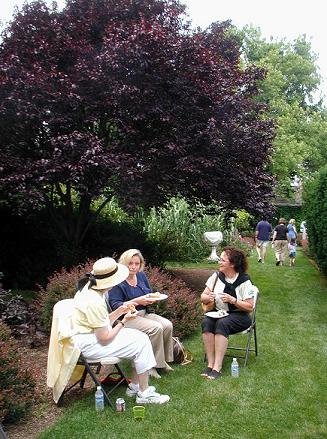
Atlock Farm never fails to delight me. The enormous hoop houses have wooden ends, the open doors providing a glimpse of fountains and flowers, glorious foliage plants, and decorative statuary. The same in the open air: splendid plants and lovely statuary. Display gardens open up from one room to another, concealed from each other by tall hedges, or opening off to the sides of a long brick or turf walkway.
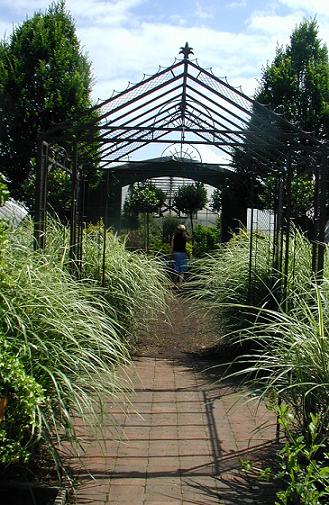
Mid-June is the tag end of the spring selling season, and still early in the growing season. By August the displays will be even more lush, beds and borders crammed full of exuberant plants. Better than a public garden in that Atlock Farm sells plants, many that they've propagated on site. They have hellebores and ferns, hostas and pulmonaria, beebalm and bananas, elephant ear and . . . the list goes on and on. Walking between a pair of these plants-for-sale areas I announced to the open air and the woman walking ahead of me, "I could take it all." Whereupon she turned around, saw who I was, and gave me a delighted hug while saying, "It's been so long!" It was a friend from back when we lived in Wilton, Connecticut ten years ago, and we haven't seen or spoken to each other in all the intervening time. We talked, hugged, talked some more, hugged again, oblivious to the people around us who were more interested in the plants. Eventually Kim's two friends wandered up and I was introduced to them. Seredipity, yes, of course. But also of course, where else would we meet but in a garden. An exchange of addresses, she left, but not before another hug. Now that she lives in Pennsylvania, though down near the border with Delaware , we'll have to make sure another ten years does not go by before we see each other again.
Beyond the display houses are other hoop houses with plants for sale. A plethora of coleus, all sorts of succulents, tender ferns, and uncommon begonias. Two of the begonias insisted on coming home with me: Begonia gunnerifolia with its light gray canes and huge maple-like leaves, as a back-up for my elderly plant which is looking somewhat poorly this year, and Begonia paulensis, with intreguingly puckered leaves. Then I spotted a display specimen of Euphorbia cotinifolia in a decorative pot. This is a plant I've always admired. The coppery leaves do indeed look like those of one of the purple-bronze leaved cultivars of Cotinus coggygria. Wound a leaf, break a stem, and the milky sap that oozes out reveals that this is indeed a euphorbia. Spotting someone I know who was helping out today, I asked if there were any young plants, and if yes, where they might be found. "Go to the last long greenhouse." said Ray. "Enter on the right-hand end. Walk two-thirds of the way down on the left, and there's a tray of small plants in 4-inch pots. If you're not around in an hour or so we'll come looking for you." I went, I found, I selected. But clearly other discerning gardeners had been there before me, because there were only eight or so pots left.
Setting the few plants I'd so far collected down near the sales area, I strolled through the garden rooms yet again. One small shady alcove was illuminated with a beautiful golden variegated ginger, Alpinia zerumbert 'Variegata', together with leopard plant, Farfugium japonicum 'Aureomaculata', its dark green leaves dappled with yellow spots, set of by a trailing veil of yellow creeping Jenny, Lysmachia nummularia 'Aurea'. Elegant.

A lovely afternoon. I found a mislaid friend, acquired some choice plants, and viewed some lovely plants in attractive garden settings. A good afternoon, a pleasant outing, time quickly passing while so much was seen and done.
The bed outside my study window has a few permanent residents: Musa basjoo, the hardy Japanese fiber banana survives from year to year with a modicum of winter protection against the cold and the voles. There's Hemerocallis 'Heart of Africa' - or at least I think that's the cultivar name for this daylily with rich, dark burgundy flowers and a brush of yellow deep in their throat. And Paeonia 'Illini Warrior', a vivid cerise pink single flowered peony. The rest of the space has a couple of survivor bulbs such as two hyacinths that surprise me every spring, and a few gladiolas that insist on surviving, generally right where I was planning to plant something else for this summer. And weeds. If I don't get the summer plants in and a mulch down, I have a marvellous display of stilt grass, the occasional stately dock and perhaps a poke weed adding stature to the ammalgamated mess.
This year I decided to continue with a tropical theme, suggested by the banana. The plants would have great foliage, flowers unimportant. And I'd use plants with somber dark foliage, alleviated with gray-leafed and white-variegated plants. And, by the way, the soil is (despite a few years of amending) still closer to its original heavy clay than a friable loam. But that's O.K. The pamphlet of cultural instructions from Brent and Becky's Bulbs mentions that my first choice, Zingiber 'Midnight', relatively inexpensive since it is raised from tissue culture, can tolerate heavy clay and grows in sun to half shade. Obviously gingers are designer-made for this site. I planted three in a wide, shallow V in front of the banana, which is close to the house foundation and the deck, to the right as you look at things. A fourth ginger was planted on the opposite side of the daylily, at some distance to the left from those three. Even when first planted, the four plants had a heavy, black hole, suck-in-the-sunlight ambiance, creating the effect of shadows while the sun was shining on them. The glossy dark leaves reveal a burgundy glow when illuminated by sunlight shining through them.
Next to be planted were some rhizomes of Canna'Russian Red', with very dark green leaves edged in deep burgundy red. Growing a modest 4- to 6-feet tall, this cultivar has small, red flowers. They're orchid type, my preference to the overblown, supersize blossoms seen on many contemporary canna cultivars. The stout, fat rhizomes were planted all the way to the left, and at the back of the bed. Their leaves will be similar in shape to those of the banana, but different in color and in carriage - how they're held on the plants. And, as I know from experience, cannas thrive in sunny sites with damp to wet heavy soils.
Also in the back row between the cannas and the banana is a straggly cane-stem begonia. It's been in the same pot for about 4 years, which might have something to do with its modest number of leaves on 3 foot tall stems. Taking it out of the pot and planting it directly in the ground seems to have done it some good - new leaf buds are already forming at the nodes. I have no idea if this begonia is summer flowering or not, but that is immaterial. It is the foliage effect I'm interested in, a matter of texture and contrast.
The next couple of plants came from Landcraft Environments, Inc., a wholesale source for uncommon tropical perennials to embellish summer gardens. Located in Mattituck, New York (on Long Island) they supply quality nurseries and garden centers in Connecticut, New York, and New Jersey, possibly elsewhere but that I don't know. I bought my plants at the Rutgers Gardens Spring Plant Sale last May.
Acalypha wilesiana 'Serrata' has deeply serrated, elongated burgundy red leaves, streaked with orange and red. The typical fuzzy, rose-red catkins are smaller than those found on chenille plant, A. hispida. Growing to 3- to 4-feet tall, it's preferred conditions are sun to part shade in a site with evenly moist soil. The textural contrast of the leaves will play very nicely against the bold oval leaves of both canna and banana.
With handsome creamy white foliage splashed with green, the maple-like leaves of Abutilon 'Savitzii' will lighten the dark foliage of canna, acalypha, and ginger. I've grown another "flowering maple" in the summer garden, delighted with its rapid growth from 4-inch pot to 3-foot tall shrub. I assume this cultivar will grow as quickly, looking at the new growth already developing on 'Savitzii' after it was freed from its 4-inch pot. Again, for sun to part shade, with moist yet well-drained soil. I'm delighted with the way the mostly white leaves with a small green blotch in the center lighten the appearance of the area.
White-edged Swedish ivy, Plectranthus coleoides 'Variegata' is the variegated plant I chose to face down the planting. It is a sprawling, falling sort of plant, suggested for use in hanging baskets, with medium dark green leaves accented by a crisp white edge. Directions for exposure are the standard "full sun to partial shade" (tell the customers what they want to hear), and evenly moist soil. Plants grow a modest 10- to 16-inches tall. By planting in the ground, I expect the trailing stems to cover about 18 inches, more if it roots down as it goes. And I suspect that that looks quite likely to happen.
Some rain, more warm weather, and the tropical look should fill in very nicely.
This afternoon was the initial meeting of the Alexandria Township Garden Club and Plant Exchange. Eight of us, alerted either by a friend or a small notice in the newspaper, gathered to discuss what this club might be about. What brought us together, I think, is a wish to find like-minded friends. People who like to dig in the dirt, grow flowers, raise vegetables, and talk about what we're doing. A modicum of bragging when things go right, and a friendly ear, perhaps even helpful advice when they go wrong. No flower shows, we decided, and nothing formal. Garden visits, both to members gardens and to public places, sounded attractive to all of us. "Civics" in the form of some garden tending for the Alexandria Township Historical Society building and the dilapidated little church that the township also owns. Not, apparently, that there's much of a garden at the church. But that could change.
Clearly, for those of us present a weekday afternoon was not a problem. However some who might have been interested could have difficulties due to work schedules or other commitments. So we agreed that meetings would sometimes also be held in the evening. But we're really just feeling our way. Should we meet in the winter months, or give it a rest? Will members each make a presentation, sharing their knowledge of decorating flower pots, propagation, or . . .? My suggestion was favorite gardening books, and each member could bring a book or two. This would be a good subject for a winter meeting when outdoor gardening is in abeyance. With myself as "gardener on the spot" for that one.
Refreshed as much by conversation with kindred spirits as the lemonade, iced coffee, and cake provided by our hostess, we went our separate ways. With much to think over, like - what shall we name our garden club? Let's hope this tender sprout takes root and grows into a healthy, vigorous organization. It's starting off well. Our next meeting, an evening one, is already scheduled for July.
The invitation read "a June garden evening at Wave Hill." Now, one of my regrets at leaving Connecticut and moving to the very western edge of New Jersey is that Wave Hill , situated as it is on West 249th Street in the Bronx, right up against the Hudson River across from the Palisades of New Jersy, is a two hour drive away from BelleWood Gardens rather than a mere 45 minute, hop-and-skip, impulse outing. It did not take much consideration to accept the invitation, with pleasure. Garden visits and long drives in a car are both made more pleasureable with a like-minded companion, so I asked my friend Lillie if she'd like to go along. She took even less time to say yes than it took me. It was arranged that I'd pick her up at work on Thursday afternoon arround 4:00 p.m. The festivities were to start shortly before 7:00 p.m., and this would give us some time to stroll around on our own.
When the day arrived there were some clouds and a spritz of rain. We're both gardeners. Rain doesn't trouble us. Hah! As we drove eastward the skies grew darker, and along about exit 39 on Rte 287, just before the connection with Rte 80 the heavens opened up and someone turned on the faucet. Mine was not the only car moving so slowly that it seemed prudent to turn on the emergency flashers. Some vehicles even pulled over to the side of the road to wait things out. Creeping along at 20 miles per hour, it became obvious that we were not going to arrive early. In fact, we were wondering if the event would be cancelled. A quick call on the cell phone, and the astonishing word that it was not raining at Wave Hill. So we continued slowly along. The discouraging message on the highway sign noted that there was a 70 minute delay crossing the George Washington Bridge. But eventually we crossed the Hudson River, it became lighter as we drove along the Henry Hudson Parkway, and eventually, 3 hours after we set out, Lillie and I arrived at Wave Hill.
It had rained, and the scent of roses perfumed the damp air. Water droplets bedewed the tips of pine needles. With anticipation we turned the corner and beheld the Marco Polo Stuffano conservatory and the flower-filled garden in front of it.
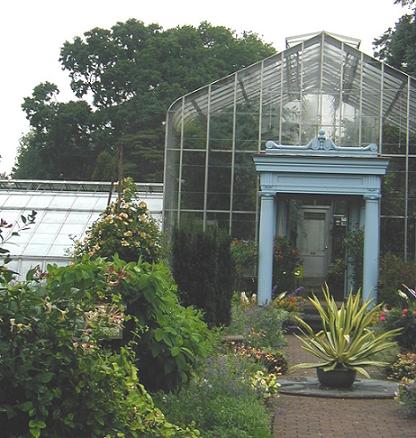
The gardens at Wave Hill are immaculately maintained. However this should not be confused with formal design. Above all, the exhuberant growth is allowed to take some direction on its own: perennials in a range from familiar to uncommon, self-sowing annuals such as the larkspur massing in the front garden, clematis in splendid display on rustic tripods made from saplings. The rustic, Adirondack style carries through with the fence made of cedar poles that surrounds the front garden, including its integral arbor and seat overhung with masses of roses, their rain-wet flowers and fallen petals enhancing the ambiance of day's end.
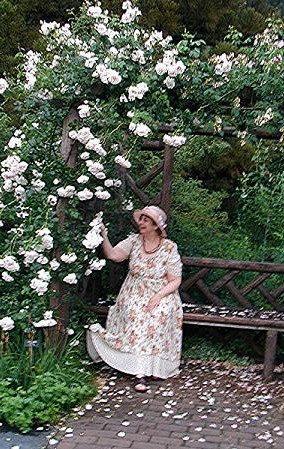
There were not that many people - perhaps some were discouraged by the rain. It only added to our feeling of visiting a private garden. This is something Wave Hill assiduously cultivates using simple techniques, perhaps something as simple as intimate, narrow paths overhung with plants that softly sweep against the passer-by rather than the roller-blade and skateboard asphault freeways found in so many public parks. Lillie and I strolled up to the Wild Garden, with its marvellous overview of the Herb Garden and the new Perkins Visitors Center, and the Hudson River. Just outside its boundaries is a new living fence of espalier pears, its four sections arranged as cordon, diamond, diamond, and cordon trained young trees. It is simple to envision its year-round display, better and better as the trees continue to mature: spring's snowfall of white flowers, summer fruit, autumn's change, and winter's bare branches in artistic, wood-cut style beauty.
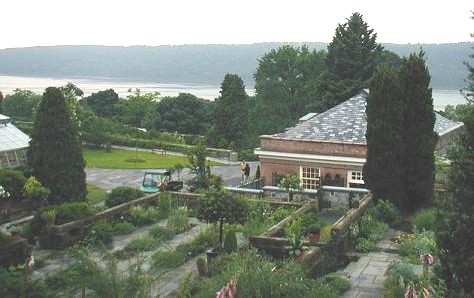
As the light began to fade, we strolled across the Great Lawn to the Pergola Overlook, roofed with vines. The small planting beds around each of its supporting columns had recently (like earlier that day) been given their summer complement of plants both in the ground and in containers. Wave Hill is noted for its numerous (and wonderful) container plantings - stately and mature specimen shrubs to seasonal and flamboyant summer embellishments. The pergola, Italianate in style, frames wonderful views of the Hudson River and the Palisades, scenery that again and again forms a backdrop for the garden. Lillie and I were enranced to find a spade leaning up in one small nook, perhaps left behind when the rains came down.
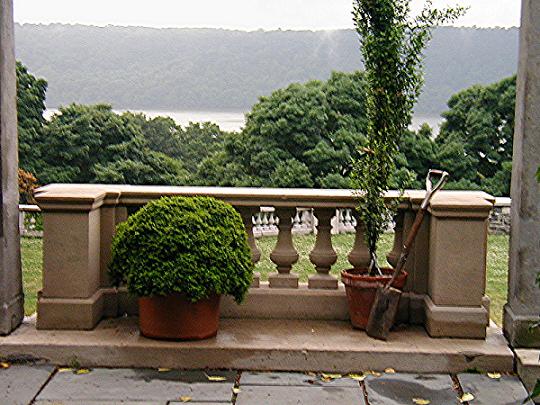
We strolled a little further, intregued by a Wardian case sitting on its sturdy support adjacent to the lawn. This, we discovered, is a display piece that is part of the Bronx Lot Florilegium project, which continues until August 28, 2005. It focuses on the diverse yet overlooked plants that grow in abandoned lots and waste places in the South Bronx. Selecting a 15 foot by 15 foot transect in a vacant lot near the Bronx River, artists Bob Braine and Leslie Reed collected 57 different plant species. Last winter the artists identified the plants, drew both the plants, geological specimens, and manmade debris found with them. Work continued with the creating of a florilegium, a book of botanical illustrations and text in the style and tradition of 18th and 19th century naturalists. The Wardian case, its sturdy support a wrought iron Victorian style table base and its contemporary wire-glass case, was filled to bursting with lush plants, the tendrils of a vine snaking out through a roof vent.
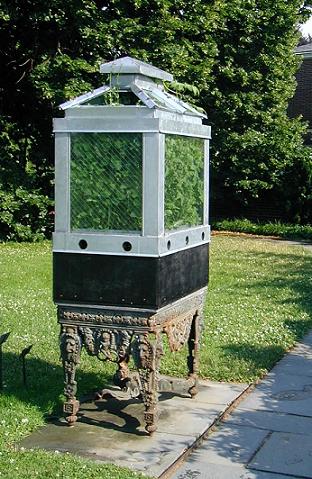
Lillie and I were the last ones left. The other guests had departed, the wine bar was dismantled, and it was clear it was time for us to go too. Happily, we got back into my car for the two hour ride back home, with so much to talk about that the journey seemed even shorter.
It's generally accepted that plants want "average" conditions, frequently translated as "moist but well-drained." That may apply to many plants, even for most plants. However those plants are actually in the middle of a spectrum which ranges from drought-tolerant members such as cacti and succulents to obligate wetland plants that shrivel and die if not kept constanty moist. (Set aside, for the moment, any consideration of the true aquatic plants such as water lilies.) Some wetlands, such as bogs, are limiting habitats. Their conditions are unfavorable to the growth of the majority of plants. In addition to soggy substrates low in nutrients, the pH of bogs is generally quite low. Though the site may be physically wet, plants growing there act is if it is physiologically dry.
Among the specialized bog-dwelling plants are some of the most unique and fascinating members of the plant world, including orchids and insectivorous plants. Not having a bog here at BelleWood Gardens, I make do with a wide, shallow plastic container set up for the purpose. I wrote an article for the Mid-Atlantic section of Horticulture magazine's June 2005 issue on how this works. Basically, there's a drain hole towards the base, closed most of the time with a cork. An overflow hole towards the top is constantly open. The potting medium is a blend of screened, long fiber sphagnum moss and granite chick grit, with a handful of aquarium charcoal added. Some hybrid pitcher plants, Sarracenia cultivars, have been thriving for several years. In addition, the dainty little pink flowered rose pogonia, Pogonia ophioglossoides, is well satisfied. Neither of these would grow in real dirt.
Bowman's root, Gillenia tridenta, is in bloom in my garden. There are two plants, not especially far apart from one another in what passes for my perennial garden on the slope behind the house. This is a great, under-utilized native perennial found in the northeastern United States and Canada. In early to mid-June it covers itself with masses of white flowers. Their 5 narrow petals give an airy, open look. What puzzles me is that one plant performs magnificently, transforming itself from a subdued green mound a couple of feet high to a stunning tapestry of white stars. The second plant is browsed by the deer that saunter through the garden. It blooms, but obviously can never make as fine a display. So tell me, why does Bambi and his family eat the one, and ignore the other plant?
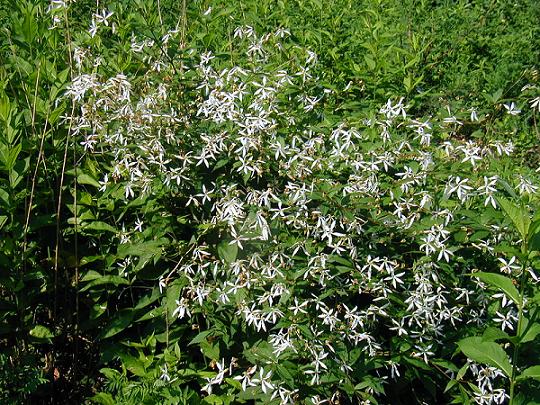
Knotweeds are thugs. Japanese knotweed, also called Mexican bamboo and fleeceflower, Polygonum japonicum, is a freely suckering massive perennial that spreads by means of wide ranging rhizomes. Small pieces of root left in the ground regenerate into new plants. Stems run through a shredder have been known to root. Pieces dropped into a waterway float downstream and root where they come to shore. In Great Britain it is illegal to move off site not only plants and pieces of plants, but even, I do believe, soil in which Japanese knotweed has been growing. Obnoxious, to say the least. Taxonomically quixotic, it has also been called Reynoutria japonica, and at various times even placed in Fallopia, and Persicaria. Said to be planted extensively in its native range - Japan, China, and parts of Korea and Taiwan - to obscure waste areas, garbage dumps, and pig pens, Japanese knotweed has been nominated as one the world's hundred worst weeds. Several states have it listed as an obnoxious weed, prohibited invasive weed, or call for its quarantine. It was introduced to the United States prior to 1890, and is still occasionally recommended for garden use.
A number of years ago I purchased Reynoutria japonica var. compacta, now known as Polygonum japonicum var. compactum, a more compact form (growing 30 inches tall rather than 7- or 8-feet tall) said to be better behaved, with nearly circular leaves and clusers of reddish brown flowers in late summer to early autumn. Its first five or six years in the garden it indeed performed as advertised. However last year and this spring is is developing more aggressive tendencies. Oh dear!
Then there's Polygonum polymorphum, a plant with better manners and less aggressive tendencies. In bloom early in June, it has large, attractive plumes of numerous tiny white flowers atop 4- to 5-foot tall stems that cluster in a vase-like clump. Suitable for sunny sites to edge of woodland conditions, this pleasant species is tarred by the brush of its rampageous cousin. No less a plantsman than Wolfgang Oehme of the landscape firm Oehme, Van Sweeden, is fond of this species and is perhaps its greatest supporter. My first plant came from him.
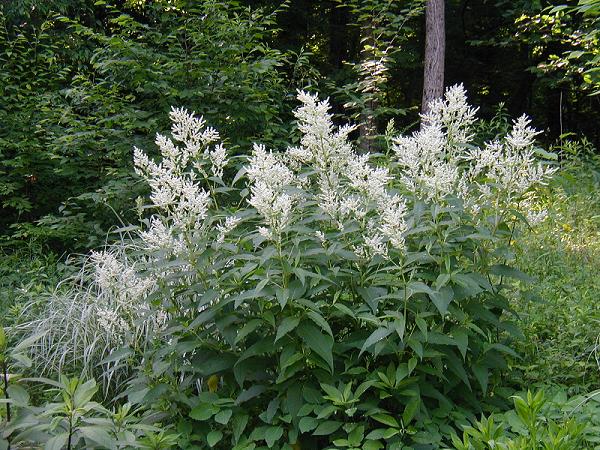
Today I spent most of the morning, more than four hours, in the garden, planting Canna 'Tropicana' in place of ornamental onions along Magnolia Way. I did some preparatory work on Saturday, wheeling two crates of cannas to the bottom of the driveway and carrying them across the drainage creek to where they'd be planted, then filling a couple of baskets with mulch and carrying them to the work site too. More mulch would be needed, but this was a start. The numerous Allium aflatunense 'Purple Sensation' were through flowering, and dames rocket, Hesperis matronalis had only a few remaining flowers. Moreover, they were setting seed. Dames rocket is considered a weed by some, for its profligate tendencies to fling seed far and wide. While I enjoy its flowers in May, as a responsible gardener I feel that it is important to dead-head so self-sown plants do not escape. Also, I prefer the lavender to lilac forms rather than the paler ones, which might show up as seedlings. In addition, encouraged by the warm weather and the rain, touch-me-not, also known as jewelweed, Impatiens capensis has grown to chest height. In some places there are invisible perennials beneath them, concealed by the nearly 5-foot tall plants. At least they are easy to pull.
I quickly developed a routine: cut ten or a dozen ornamental onion stems close to the ground. Recut into thirds or quarters so they'll fit into a basket. Pull jewelweed and stuff into same basket - it's juicy enough that even stout stems crush easily. Pull any other weeds that might be in the area. Clear enough linear area to plant three or four cannas, each approximately 18 inches from the next one. Use a sturdy three-prong hand cultivator to loosen the soil. Add a capfull of Osmocote slow-release fertilizer, and cultivate again to mix it well into the soil. Place a canna in the depression, settle the soil around it, and move on to the next one. After that set of cannas were planted, mulch. Then go back to cutting down alliums, pulling weeds, dump in compost heap, refill basket with mulch, back across drainage creek, etc.
Soon enough I was sweating heavily. My hands were sufficently dirty that any attempt to wipe off my glasses would have left them smeared with mud. So I just kept gardening.
'Tropicana' is a colorful canna, its wide leaves marked with peach and red on dark green ground. Sunlight shining through the leaves of even the smallish, about 12 inch tall plants I was setting out, gave them a luminous appearance. The warm wet weather will encourage their speedy growth to 6-foot-tall maturity. They'll look great backed up by Persicaria 'Red Dragon', the pointed, red flushed leaves accented by a silver chevron. I also planted 30 or so cosmos, a mixed tray of fuchsia, pink, and white. I'm not positive I'll like the flowers paired with the canna foliage, but there's only one way to find out for sure.
I am fond of cannas for several reasons: they adapt nicely to my heavy clay loam soil, the deer pass them by, and they are great foliage plants. The first two reasons are helpful but let's get real, I cultivate plants for their good looks, not merely because they grow. If that was the case I'd just sit back and allow the weeds to take over - which they're trying to do anyhow. The only drawback to cannas is the fact that they are not winter-hardy in my garden. Well, they are if grown near enough to the house that sufficient warmth seeps through the foundation to protect the rhizomes from freezing. That worked for several winters, until the wretched voles ate each and every piece. That means that after a black frost all cannas must be cut back, dug, and prepared for winter storage in the garage. But that's months away. Not to worry now, just enjoy the anticipation of summer's luxuriant foliage effects.
How much rain does the garden need? How much rain has it gotten? In "The Gardener's Year," Karel Capek's little book of amusing essays on gardening first published in 1931, he has one on The Blessed Rain. And rain is mentioned again and again in other essays. Clearly, Capek recognized how gardeners and farmers alike focus their attention on this subect. We always find this topic one that's suitable for endless conversation: it's been too wet, too dry, came down too heavy, and (less frequently) it's just right. Supposedly, gardens require an inch of rain a week. That's correct if your soil is a nice loam. I have heavier clay loam to downright clay, and it holds on to moisture very well. Less than an inch a week will suffice. In Massachusetts, where my son gardens on very sandy soil, an inch of rain per week is too little.
Weather reports are fond of presenting averages, a way of looking at things that is of no help whatsoever to a garden first parched with drought, then inundated by a torrential deluge. The average may be typical, even normal, but extreme swings in delivery are critical. An exceptionally dry summer followed by a hurricane's worth of rain in a single day in September does not restore plants stressed by three months of arid conditions. It presents another problem. When the soil dries out to that extent it must be gently refreshed with a slow soaking rain over several days. Abrupt delivery in a matter of hours runs off the dusty surface and does not moisten the soil or recharge the ground water.
A rain gauge, possibly more than one, is the only way to measure what a beneficial providence has (or has not) provided. Rather than guessing ("It rained so heavily last night, we must have gotten a lot.") stroll outdoors in the morning and see how much water was actually delivered. Make a note of when and how much in your garden journal, even if it is no more than a calendar with space to make such notes in the space for each day. The records inform you if there's been enough rain, if you need to supplement with watering can or hose, and, over several years of record-keeping, if dry spells in July are to be expected. Empty the rain gauge, and it's ready to measure whatever rain whenever next it comes. Conventional advice is to place the rain guage out in the open, away from any buildings or walls or overhanging branches. I've been thinking that it would make perfect sense to have a second rain gauge down in the woodland garden. If trees intercept that much rain, I'd like to know how much less the plants in that garden received. In a very light, mizzling sort of rain they might not get enough to be worthwhile. And I, their caregiver, would be fooled by the measurement from the gauge up by the house that is out in the open into thinking they have had enough water from the rain when they did not.
These musings are philosophical, as currently we have had enough rain to satisfy slugs and snails and plants. Farmers trying to make hay are the ones who are grumbling right now. Yesterday's weather was more like what I'd expect in August, or perhaps Louisiana, and I bet the bananas were just loving it!. Completely overcast gray sky. Grumblings of thunder. Brief spats of heavy, tropical downpour and periods of fine, mizzling drizzle. I think the air was simply too saturated to hold any more moisture. Let's see how this works. There's only so much vapor that air at a given temperature and pressure can sustain. That's its saturation point. More water vapor can exist in warm air than in cool or cold air. When saturated air cools, some of that water vapor condenses to liquid - explaining why my eyeglasses fog up with moisture when I step out of the air-conditioned car or house into the subtropical conditions of summertime New Jersey. However that's condensation. The air closer to the ground was certainly not cooling off yesterday. Rain, whether heavy or light, falls from the sky as precipitation. Yesterday's total was over 6/10ths of an inch.
My garden friend Ellen was planning to attend a garden club meeting at Well-Sweep Herb Farm in Port Murray, New Jersey. Very kindly, she invited me to join her. Not, you understand, that she is a member of this particular club, but rather that she thought a visit to Well-Sweep and an opportunity to meet the members of the club made a two-for-one that was hard to pass up. The weather could have been better. Not that it was raining mind you. It was the three H's: hazy, hot, and humid. Not sweet enough to melt in rain, gardeners can tough out the worst kind of weather when there's a garden to visit and plants to be (potentially) purchased.
Well-Sweep Herb Farm has 120 acres, with all the usual nursery accoutrements of cold frames, hot beds, and hoop houses for propagating plants and carrying tender ones through the winter. There's an old house, residence for the owners; a small barn that houses the shop; and a poultry yard of fancy chickens, onagadori from Japan. Smaller, crow-sized birds, the hens are a soft beige-brown color and the more colorful roosters have very long black tail feathers. I think they are show birds, rather than being raised for eggs or meat, though these were not being groomed for competition. Lots of cackling and crowing going on. More importantly, there is a half acre of beautiful display gardens. By this time in June even the most tender plants have been brought outdoors. Rosemary standards perhaps 16 years old, trained to a single stout trunk with a well-filled head of aromatic foliage, formed a line along the brick walk that formed one side of the garden. There were two lemon verbena standards, even larger, and almost 30 years old. An organically run nursery, Cyrus Hyde and his wife feel that plants are better out of their pots and in the ground. So each summer these venerable plants are allowed to stretch their toes into the unfettered soil of the demonstration gardens. There's an Elizabethan knot garden, as well as a demonstration bed with numerous rosemary cultivars, and another of different lavenders.
A long brick walk to the left of these gardens is lined on both sides with lamb's ears, Stachys byzantina. At the far end is a charming little building, square and tall, just a little wider than the door. It is the "necessary" or outhouse, a two seater in this case. Nicely furnished with a small throw rug and a couple of pictures, it is made light and bright by a curtained window in the wall adjacent to the door. For this necessary is still functioning as intended. "At night," we were told by Cyrus, "the lamb's ears silvery leaves act as guide markings to get you where you need to go."
Nearby a bed was bisected by a row of four Scotch thistles, Onopordum acanthium, their mealy, silver leaves armed with stout spines. Already over 5 feet tall, the thistle flowers were already forming. And seedling plants in the adjacent brick walk suggested just how freely this plant will self-sow. Beyond this bed and a bordering strip of lawn was another bed, backed up by a stone wall. In this bed were several groups of the healthiest Madonna lilies, Lilium candidum, that I have every seen, their sturdy stems well dressed in apple green leaves, and topped with many flower buds. A diversity of salvias, some dwarf pomegranates in flower and first fruits just beginning to form, mandrake, oriental poppies in bloom, and more, added diversity and color to the display.
A few fruit trees: a pear, a venerable apple, and a cherry, add to the appeal of this beautifully maintained nursery, as does the fragrance of old roses in bloom. A refreshing drink of rosemary lemonade cooler completed the ambience given our other senses of sight, and scent. A pleasing outing providing many pleasant memories. Should you care to make a visit of your own, it is Well-Sweep Herb Farm, 205 Mt. Bethel Road, in Port Murray, New Jersey 07865. Their telephone number is 908 / 852-5390.
There is a gardened area at the bottom of the driveway, close to the road. It's not what I would call designed, by any stretch of the imagination. You see it when driving by, when turning in to the driveway, when walking down the driveway to the mailbox. Clearly some color, that is to say flowers, would be nice. But not an area with meticulous attention to detail. It got its start with a hundred or so Narcissus 'Dutch Master', the big yellow trumpet that is commonly offered in place of 'King Alfred'. The bulbs were planted in three thick rows, separated by the common orange-flowered ditch lily, Hemerocallus fulva. Which has done so well that any semblance of rows has vanished into a sprawling mass. I moved in some horse mint, Monarda didyma which is establishing nicely, and adds its lilac-lavender flowers in mid-summer. As well, I scavenged some wild-growing phlox, Phlox panniculata, which is intent on turning things into a monoculture. That's going to be a challenge for it, as everything else has similar ambitions. Typically, the phlox blooms with pinkish lavender flowers, but a white one will show up every now and then.
The site is sunny. It is also quite wet, and the soil is a heavy clay loam. I tried planting a number of liatris, Liatris spicata, as dormant, packaged corms. They grew well the first year but did not return the following spring. Too wet in winter would be my supposition. I have to think about this, as I think the lavender-purple wands of liatris would be a good addition. I added some lily bulbs this spring, and hope they'll do better. When I visited Ellen Hornig of Seneca Hill Perennials in Oswego, New York last fall I got several bulbs of the double form of tiger lily, Lilium lancifolium 'Floro Pleno'. Sterile, (as is the single, triploid, form) it reproduces by means of aerial bulbils borne in the leaf axils. They look like glossy black peas, nestled against the wooly stem. The flower's petals are deep orange spattered with dark freckles and recurved, into a turk's cap. The double, from pictures I've seen, are nicely tidy, rather than an overblown, tousled, dandelion look. If I decide it's too wet, I can always move them this fall.
There are some grasses too, a couple of Panicum virgatum 'Heavy Metal' and a variegated Miscanthus sinensis.
And then there's the cup plant, Silphium connatum, also known as S. perfoliatum var. connatum. One plant, as the up-market designers like to put it, "makes a statement." Once established, a 6 foot tall plant is on the petite end, as they can reach 8- to 10-feet tall, and 4-feet wide. The square stems are self-supporting. It gets its name from the paired leaves, which merge at the stem and form a small depression, or cup, in which rainwater or heavy dew collects. Sometime after mid-summer, from mid-July into early fall, plants open masses of 3-inch wide yellow daisies on the upper portion of each stem. Most silphiums are native to the prairies of the midwest. This one is found in Maryland, North Carolina, Virginia, and West Virginia. Not quite New Jersey, but closer than most. Mine has been here at BelleWood gardens for about four years, and is well established.
I neglected to dead-head after it flowered last year and the year before, and cup plant is also showing how much it enjoys the heavy clay loam soil and constant moisture. It's self-sowing. Truly, one cup plant is all this area can support, if, that is, there's to be any diversity. This morning I arose at 6:00 a.m. while all was still cool as the sun was coming up. Outdoors not half an hour later, I dug 21 young cup plants. And there are more. Three were replanted on the slope at the top of the driveway where there's room for them, nine were potted for a plant swap, and nine more were potted for a friend with a small wholesale nursery business. You'd never know they were moved, no flagging or wilting. Quite the opposite for the two self-sown Joe Pye weed, Eupatorium purpureum, that made the reverse trip down the driveway, from where they'd sown themselves to the lower area. They were doubled over like Victorian maidens having a swooning fit. Everything, planted or potted, was well watered, and I'm sure the night air will revive them.
Comment: Cherie says: Judy writes some lovely descriptions and I had much amusement from reading this entry about cup plant. The tiger lily and the Joe Pye weed descriptions and metaphors were a delight and something to which my mind returns to often. It's bookmarked for regular reading here! ;)
Yesterday's heat and humidity collapsed in a late afternoon thunderstorm. Black clouds rolled in, there was muttering and grumbling in the distance, and then the storm arrived with a rush of heavy rain. This is the first real thunderstorm since last year, and I'd forgotten how refreshed things are after the storm passes. The temperature dropped, as did the humidity. The first cell delivered approximately .45 inches of rain, with a second cell arriving about an hour later, with the same amount of precipitation. Badly needed, no mistake, but a deluge is not as useful at replenishing the parched soil as is a slow, steady soaking rain. Not complaining, mind you, just making an observation.
Today was also hot and humid. I planted a large, 3-foot tall cane stem begonia and a cordyline with fuchsia-colored new growth, both near the large banana planted in the ground. Then, since the front row of potted tomatoes left some room at the corners, I filled two smaller pots with potting compost, then planted three Nero di Tuscano kale seedlings in each one. It was an act of faith when I sowed the seeds, now validated. Nero di Tuscano is one of the long leaf kales, with crinkled, savoyed, rugose leaves. The flavor is wonderful with dried white beans cooked in the Tuscan manner.
And after that small amount of digging and delving, soil mixing and planting I was dripping with sweat so called it "Enough." for the day.
17 August Update
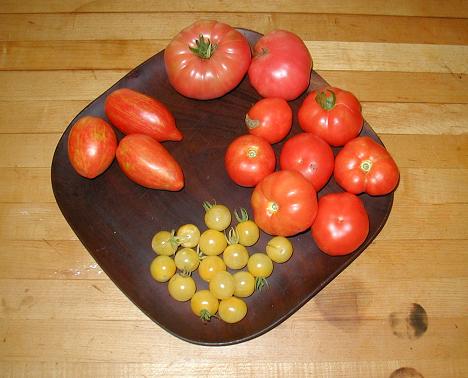
I've been picking delicious tomatoes for several weeks. Marmande, on the right, was the first to ripen, and keeps right on producing clusters of delicious, smallish, round red tomatoes, excellent in salads. Next in sequence was Lemon Drop. Paul and I both really like their taste, and enjoy picking a few just as a snack. Indeterminate is right on the mark - Lemon Drop is going to reach for the chimney if it keeps on growing as it has. Speckled Roman is producing nice meaty yellow-striped plum type tomatoes, also very good flavor to slice for salads. And Win-All is now ripening, with flavorful pinkish red irregularly-shaped mid-size fruits. Tigarella has flowers, but has yet to set a single fruit. A real dud, but more than made up for by the harvest I'm getting from the other four plants. Tomato gardening in outsize pots is definately worthwhile.
Back to earlier entry:
I was at Kingwood Gardens, a small family-owned garden center on Rte. 12 in (where else?) Kingwood. One of the appealing aspects of this nursery is that they do raise many of their own annuals and vegetable plants. While perusing their offerings, I took a look at the selection of vegetables. Fascinating, as Mr. Spock would say. There were 6-packs and individual pots of a wide range of heirloom tomatoes. Unable to resist, I found myself clutching five pots and walking towards the checkout register.
Marmande is a French heirloom, said to dependably produce heavy clusters of 4- to 6-ounce, dark red fruits that are slightly flattened, lightly lobed, meaty, and have an excellent, complex, slightly tart flavor. Though inderterminate (that means the vines keep growing as long as the weather is favorable, stopped only by shorter days and cooler nights of autumn) the plants are supposed to bear relatively early, and may be field-grown without staking (but that might just mean they are allowed sprawl.)
Tigerella is an English variety developed at the Glasshouse Research Works that bears red to orange fruit with green stripes. The inch and a half to 2-inch diameter fruits weigh about 3 ounces, and are said to be meaty, with a tart, tangy flavor. The large inderterminate vines are said to bear heavily.
Wins All was introduced in 1924. Though yields are moderate / lower than average, the pink, slightly flattened beefsteak fruits are supposed to weigh a pound or more and have an outstanding flavor, sweet with a little zip. This variety has potato leaf foliage, similar to Brandywine, a well-known heirloom tomato.
Speckled Roman is a paste type tomato, with meaty orange fruits striped with yellow. Said to be a very productive cross between Antique Roman and Banana Legs.
Lemon Drop is an indeterminate-growing cherry tomato that is supposed to be a heavy producer, bearing large numbers of 3/8- to 3/4-inch bright lemon yellow fruits with a well-balanced tart / sweet flavor. "Large numbers" could be ominous. Other cherry tomatoes I've grown in the past easily outproduced my ability to keep them picked.
Why only five? Well might you ask. To begin with, our driveway is perhaps the sunniest part of the property, and my husband has this odd notion that driveways are for cars rather than plants (which explains why my greenhouse is attached to the side of the garage rather than in front of it.) So the tomato plants were going to have to live in pots. Fortunately I just happen to have five rather large plastic pots, in the 22- or 24-inch diameter range. And there's a slatted wooden pallet-type plant stand I made one year, that tucks up against the house where it gets sun from just before noon until late afternoon. It is large enough to hold the five pots in a row of three against the house, and a row of two pots offset in front of them.
Of course, these tomatoes had to have a good start in life. I mixed up two bags, each a cubic foot in volume, of Soil King Leafy, with sufficient Pro-Mix, a blend of peat moss, perlite, and vermiculte, to result in a nice light fluffy mix. That quantity filled one pot, and a quarter of the next one. Did I mention that the day was hazy, hot, and humid? Filled a pot, started filling the next, wheeled the garden cart back to where the bags of soil and Pro-mix were, blended more soil, and did it again, and again, and again. After all the pots were filled I planted my five little tomatoes, which took much less time than the labor that came before.
Scoop a hole in the center of the pot. Add some fertilizer and a heaping tablespoon of magnesium sulphate, aka Epsom salts. Solanaceous vegetables such as tomatoes, peppers, and eggplants appreciate some extra magnesium. Stir everything up. Tip the tomato out of its pot, wrench off the lowest three or four leaves, and bury the plant deep enough that the next remaining leaves are just above the soil. Tomatoes will make roots all along the buried portion of the stem. The more roots, the better a plant's ability to absorb moisture and nutrients. Watered the plant, backfilled the hole, tucked its label against the edge of the pot and went on to plant the next one. A late afternoon thunderstorm ensured they were well watered.
Now to find some concrete reinforcingwire to make tomatoe cages. And wait.
My daughter has a blog. A blogging friend of hers sent around a meme about books. It asks, first and foremost, the total number of books in your house. Mira counted 794 that belong to her and her husband. Lots of science fiction, crafts, gardening, and cookbooks, as well as several dictionaries and reference books. That count excludes four bookshelves and three boxes of books that belong to their three daughters. The meme then asks what was the last book you bought, the last book you read, and 5 or 6 books that you read often, or that mean a lot to you. Mira asked me to enumerate the books in our house, mentioning that her guesstimate was in the four figures.
I have lots of bookshelves in my study. The first winter we were here in New Jersey my friend John Horn came and stayed with us for a week, and made them for me. There are 9 sections of 3 shelves each. They cover two walls from ceiling to somewhat more than halfway to the floor, one wall with four sections, the other with three, and two more sections that wrap around one corner. You get the idea. Lots of shelf space. And it's all filled, with books stacked behind the door, a few odd volumes hither and thither on the floor, waiting to trip me up, even a few paperbound books sideways over the the shelved volumes. And we're not even talking about the boxes of books I've authored that are sitting in the closet, waiting to find a home in someone else's library.
I did a rough count of a couple of shelves, then multiplied. Including both paperback and hardcover, but ignoring pamphlets, I came up with the figure of approximately 700 gardening / horticulture books in my room. Since there are 10 more bookcases in the house, plus 40 or so feet of shelf space in Paul's office, as well as the science fiction paperbacks on the shelves at the bottom of the staircase I would say that Mira's estimate of books in the four figures is obviously correct.
My favorite gardening books is a more difficult question to answer. Perhaps I'll mention four books that strongly influenced me as a gardener.
First and perhaps foremost is "The Little Bulbs, A Tale of Two Gardens" by Elizabeth Lawrence. I eventually found a copy of my own, the 1957 edition published by Criterion Books. Miss Lawrence writes in an affectionate, observant, and scholarly manner about the bulbs in her North Carolina garden and in Lob's Woods, the Cincinnati, Ohio garden of Mr. Krippendorf. I had the good fortune to lecture at Wing Haven in Charlotte, North Carolina, just up the street from the Lawrence garden. The current owner was gracious enough to invite me to see the garden I had visited in my mind so many times. And thanks to my friend Sydney Eddison who has friend and neighbor that is a granddaughter of Mr. Krippendorf, I have snowdrops here at BelleWood Gardens that are ex, ex, ex Lob's Woods.
M.M. Graff's "Flowers in the Winter Garden" is another seminal text in my development as a gardener, published in 1966 by Doubleday and Company. Dicky has a keen eye and a sharp wit, announcing her likes and dislikes without reserve. Much of the book is devoted to little bulbs, especially crocus, but she also includes some winter-blooming shrubs and perennials. While we've never met, Dicky and I have become correspondents. Dicky is in her early 90's. Her ascerbic personality comes through as we write of what's in flower in our gardens, what our cats are up to, the pheasant that showed up in her Brooklyn garden and the wild turkeys in mine, and how we are getting along. I've annotated some marginal notes, when I bought certain little bulbs, or when they bloomed. A quick flip through the pages shows some were made in 1969. And at the time the book was priced at $4.95. With color pictures, in signature.
I'm not quite sure where I found "Garden Guide" by Ludwig Koch-Isenburg, translated by H. L. Edlin. First published in Germany in 1964, the English translation is copyright Thames and Hudson, in London in 1965, and it was then published in America by Viking Press in 1966, priced at $5.95. My copy was marked down to $3.95. There are a few pages of color illustrations here and there throughout the book, a few more photographs in black and white. But what I enjoy the most are the black and white line drawings. The basics are here: ramblers and climbers, why must plants bear Latin names?, the small front garden, and more. The is a chapter on regal lilies (not Lilium regale mind you, but about the queen of bulbs in general.) Giant perennials, no garden without grass or fern, weeping trees surveyed, sub-tropical plants in the open air - all heady stuff to the novice gardener just starting down the garden path, writen in an informative, encouraging manner.
Then there is "Wild Wealth" by Paul Bigelow Sears, an ecologist, Marion Rombauer Becker (of the cookbook Rombauers), Frances Jones Poetker, a flower arranger, and Janice Rebert Forberg, who did the graceful sepia tone illustrations.Published by Bobbs-Merrill Company in 1971. Fond as I am of this book it is difficult to categorize. Marion Rombauer Becker begins her section, the major part of the book, with a chapter headed a love affair with the land. That really sets the tone for the reader's journey through her garden, a pleasant stroll accompanied by explanation of plants and design and garden chores, the changes of the seasons and cycles of growth.
How many gardening books do you have? What are your five favorites? What's the most recent that you've bought, and the most recent that you've read? Contact Me if you'd like to share your garden bookshelf information.
Today was the day that the red spot banana in my bedroom moved outdoors for the summer. The smaller one, which had wintered in the great room and is actually busy making bananas, was thrust out the front door a few weeks ago. But the bedroom banana, that was a major operation. To begin with, happy under the skylights and in a large pot, it is now about 9 feet tall. That's not so critical (ignoring the two turns to navigate the staircase and the chandeliers in the bedroom, balcony hallway, and staircase landing.) It is the weight of all the dirt in the pot, making it heavy enough that two men cannot manage it (this was discussed between the two guys. Fortunately discretion held sway.) So. I brought a blue plastic tarp upstairs. Tipped the whole thing over: banana, pot, and all. Started excavating soil from around the edges of the root ball until I could slide the whole mass out of the pot. Note to self: charming as a rounded pot may look, the fact that the equator is larger than the opening does present some difficulties when taking plants out.
It's the soil that provides the weight. Once I'd lightened the load it was simple enough to slip the rootball into a large garbage bag and, banana fronds rustling behind me, carry it down the stair, through the great room, and out of the house on my own. This one has been planted directly into the ground across the lawn from the deck, where it will get some direct sun and also partial shade.
The other banana, a mere wisp of a thing at about 7 feet tall, was potted on into a larger pot. The fruiting culm will die, but it is already making a couple of pups that will replace it. Wanting a more suitable location than unceremoniously stranded outside the front door, I set a sturdy pallet outside the stairwell window where there was a bare space between some azaleas and pieris. Well, not exactly "bare," not until I moved a small Osmanthus heterophyllus 'Variegata'. But it hadn't been really doing well in that space anyhow. As well as the banana, I moved the Chinese fan palm, Livistonia chinensis, from my bedroom to the pallet, and added a large copper leafed New Zealand flax, Phormium tenax. The three plants in their large individual pots really fill the space nicely, add a tropical look to the front of the house, and they should enjoy their summer vacation outdoors. Again, like the banana in the ground, they'll get some sun but mostly bright light.
Today was the book signing for "Bulbs for Garden Habitats" at the Agway on Main Street in Clinton, NJ. Yesterday's rain continued overnight and into the morning. As I loaded books into my car the concern was what we'd do if the weather continued to drizzle. Fortunately it improved to broken clouds and sun, albeit rather humid. Carol Thompson arrived just minutes after I did, so as I pulled a nice metal mesh cart with fat rubber tires loaded with books towards the gazebo in the plant sales area she started to unload her harp. It was one of her smaller ones (the great, golden Celtic harp is taller than either of us), with a beautiful, colorful peacock on the sounding board. Carol was ensconced in the gazebo. I had a round table, nicely covered with a tablecloth and shaded with an umbrella. Another, similar table was made ready for Don, the salesman from the Netherlands Bulb Company. An assortment of summer bulbs made a pleasant centerpiece. As well, we took a metal tea cart and arranged pots of cannas, dahlias, and elephant ears, all in lush growth.
Refreshments were quickly brought out and set up on yet another table, fortunately larger. There were tomato rosemary biscuits, herb bread with a lovely embellishment of chives and parsley like a painted design on the surface, marinated mozzarella balls, herbed goat cheese (3 Tablespoons each of fresh thyme, rosemary, parsley, and some garlic, as well as black pepper), a veggie spread, spiced herbed mixed nuts, and a large cooler of ice tea with herbs. What better way to spend a morning than in a garden - and indeed, with all the fabulous pots of roses in bloom, as well as other shrubs and perennials, hanging baskets, and more it truly looked "gardenesque." A real delight: pleasant company, dainty treats, soothing music, and garden talk. I had a good time, as did all the customers who serendipitously found themselves attending a party, and others who came anticipating one.
At the third visit to the doctor (different doctor than the one I saw for my first two visits) we agreed that gardening / not gardening did not seem to make any much difference. A week's rest did not reduce the fluid in my right elbow. Reluctant to perforate it yet again, the advice was to go ahead and garden. Keep it wrapped during the day, but not at night. And, let's try an NSAID, a non-steroid anti-inflamitory. Naproxen is available in a lower dosage as an over-the-counter drug, and this is what we're trying first. After four days the swelling is less, but it is not completely gone. I'm to call in after a week, and we'll discuss whether to escalate to prescription strength. Meanwhile, it is so nice to be able to weed and work in the garden with both hands!
Weeds are running rampant. I've been doing my best to vanquish the garlic mustard. Now that it is beyond flowering and into early seed set I pull, snap off the top portion with the slender pods and toss them in the trash. The bare-root bottom portion is discarded at the edge of the driveway. If the weather cooperates, it is sunny and dry enough for them to shrivel without attempting to rebloom. It has certainly been dry enough you'd think they'd wither without my needing to weed - the soil is dust-dry in places. Today is overcast and drizzle-to-light rain, welcome indeed.
Touch-me-not, Impatiens capensis, is getting large enough that some snap with a hollow "tunk" rather than just come loose from the ground if I yank too high up on their stem. Weeds, I've discovered, really need to be pulled from close to their roots. Some, garlic mustard and touch-me-not, come loose with relative ease. Others, such as white snakeroot, Eupatorium rugosum, need the encouragement of a three-pronged scratcher / cultivator. The Circle-hoe cultivator, both the smaller hand tool size and the larger, long-handled stand-up-to-work version, are great for seedling weeds with shallow roots. Weeds with the ability to regenerate from the roots - garlic mustard, for example, or dandelions - may be slowed down if they are beheaded, but they are certainly not permanently evicted.
Bare ground is an invitation to germination of new weed seeds. It is best if I mulch as I weed. When I'm well organized I use two supersize heavy-duty plastic nursery pots, about 15 gallon size with two handles. One is filled with mulch and taken to the work area along with an empty container. Weeds go into the empty container, mulch is taken from its container and applied to the tidied-up space. When the mulch container is empty, its counterpart is usually full of weeds. That one is taken to the compost heap for dumping and refilling with mulch. Back to the garden area, weeds into the empty container, mulch from that container . . . round and round it goes.
While I was on "No Gardening" for a week, Paul helped clear an area behind the peonies (well along in bud and beginning to flower) that had become frightfully overgrown. We're talking multiflora roses, box elder and other self-sown saplings on the way to becoming treelings, often laced together with honeysuckle vine. We'd go out in the morning before the sun reached the area. Paul would lop stuff down and I painted the stumps with brush killer to retard their regrowth. I've made my own handy, dandy applicator for this purpose: take a small glass jar with a tight fitting metal lid. I used a small, squat mustard jar. Punch a hole in the lid, from the underside. Widen the hole sufficiently to force the wooden handle of a small disposable foam paintbrush through it, with the applicator portion inside the jar. Keep in mind that you want a tight fit so the handle doesn't slide. Now pour some brush killer into the jar, filling it halfway or two-thirds full. Adjust the paintbrush so the foam applicator just clears the bottom of the jar. Now it is easy to apply the chemical directly to the freshly cut surface of each stump. For safety, it is prudent to write "brush killer" with an indelible marker on the lid before filling the jar. Of course, there is now a mountain of debris to be cut into more manageable lengths and disposed of.